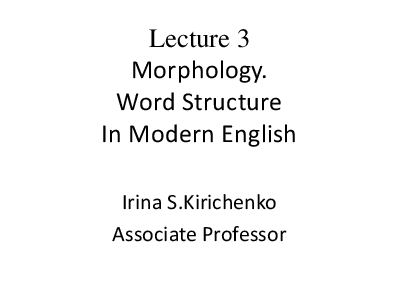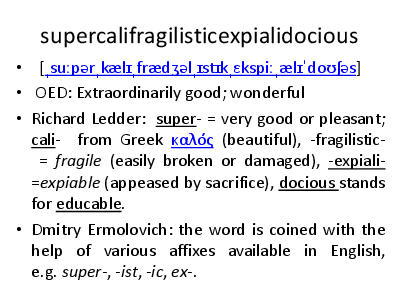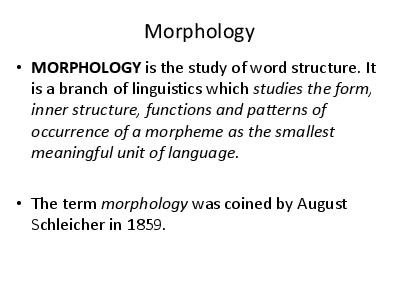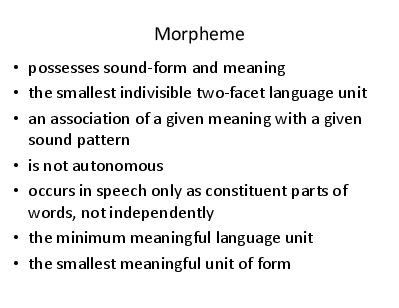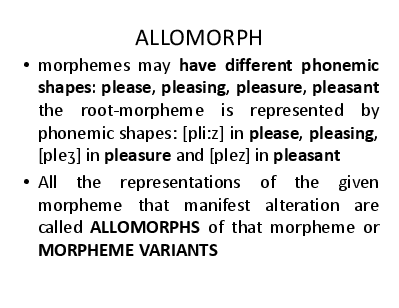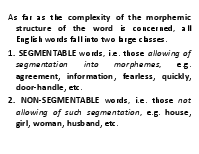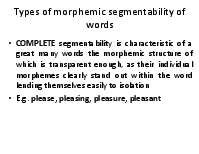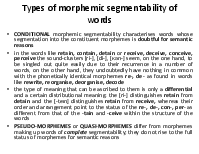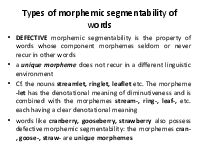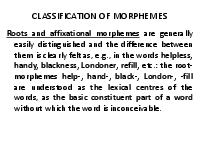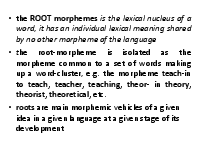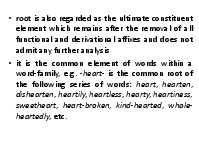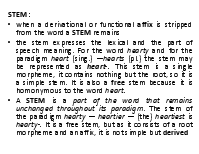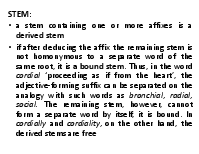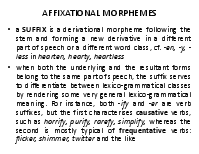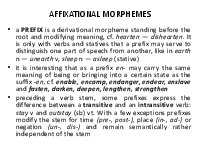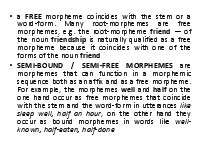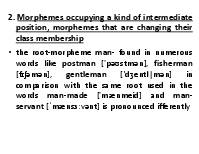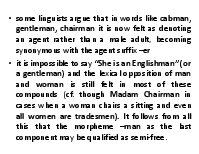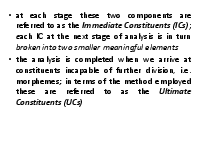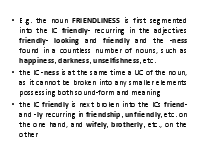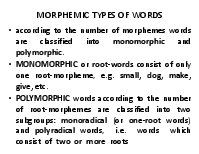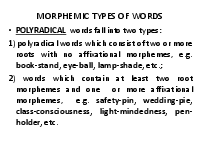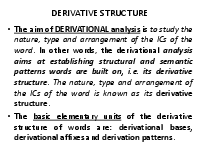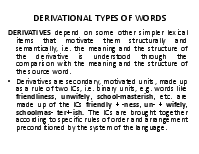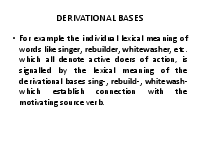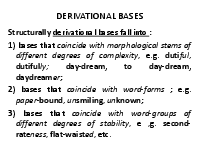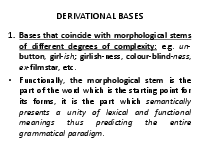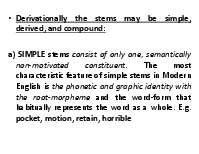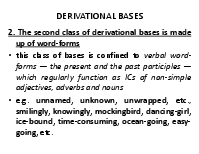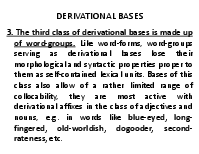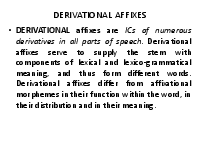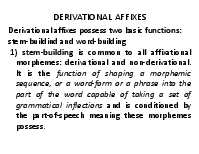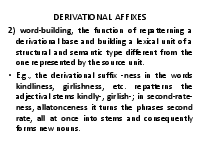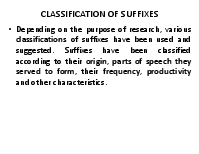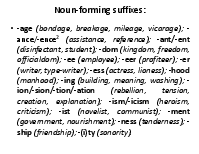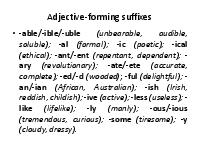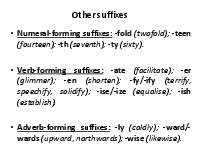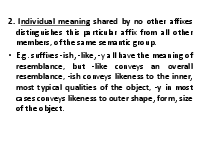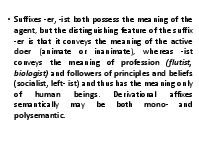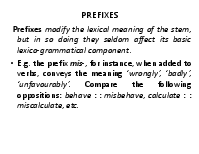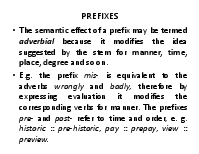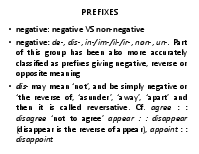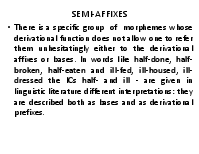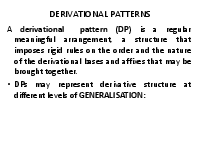Lecture 3 Morphology. Word Structure In Modern English
-
Irina S.Kirichenko
-
Associate Professor
supercalifragilisticexpialidocious
-
[ˌsuːpərˌkælɪˌfrædʒəlˌɪstɪkˌɛkspiːˌælɪˈdoʊʃəs]
-
OED: Extraordinarily good; wonderful
-
Richard Ledder: super- = very good or pleasant; cali- from Greek καλός (beautiful), -fragilistic- = fragile (easily broken or damaged), -expiali- =expiable (appeased by sacrifice), docious stands for educable.
-
Dmitry Ermolovich: the word is coined with the help of various affixes available in English, e.g. super-, -ist, -ic, ex-.
Morphology
-
MORPHOLOGY is the study of word structure. It is a branch of linguistics which studies the form, inner structure, functions and patterns of occurrence of a morpheme as the smallest meaningful unit of language.
-
The term morphology was coined by August Schleicher in 1859.
Morpheme
-
possesses sound-form and meaning
-
the smallest indivisible two-facet language unit
-
an association of a given meaning with a given sound pattern
-
is not autonomous
-
occurs in speech only as constituent parts of words, not independently
-
the minimum meaningful language unit
-
the smallest meaningful unit of form
Morpheme
-
boiler, driller fall into the morphemes boil-, drill- and -er (cf. to boil, a boil, boiling and to drill, a drill, drilling, a drill-press)
-
flower-pot and shoe-lace are segmented into the morphemes flower-, pot-, shoe- and lace- (cf. flower-show, flowerful, etc., shoe-brush, shoeless, etc., on the one hand; and pot-lid, pottery, etc., lace-boots, lacing, etc., on the other)
ALLOMORPH
-
morphemes may have different phonemic shapes: please, pleasing, pleasure, pleasant the root-morpheme is represented by phonemic shapes: [pli:z] in please, pleasing, [рlеʒ] in pleasure and [plez] in pleasant
-
All the representations of the given morpheme that manifest alteration are called ALLOMORPHS of that morpheme or MORPHEME VARIANTS
-
As far as the complexity of the morphemic structure of the word is concerned, all English words fall into two large classes.
-
1. SEGMENTABLE words, i.e. those allowing of segmentation into morphemes, e.g. agreement, information, fearless, quickly, door-handle, etc.
-
2. NON-SEGMENTABLE words, i.e. those not allowing of such segmentation, e.g. house, girl, woman, husband, etc.
Types of morphemic segmentability of words
-
СOMPLETE segmentability is characteristic of a great many words the morphemic structure of which is transparent enough, as their individual morphemes clearly stand out within the word lending themselves easily to isolation
-
E.g. please, pleasing, pleasure, pleasant
Types of morphemic segmentability of words
-
CONDITIONAL morphemic segmentability characterises words whose segmentation into the constituent morphemes is doubtful for semantic reasons
-
in the words like retain, contain, detain or receive, deceive, conceive, perceive the sound-clusters [ri-], [di-], [кən-] seem, on the one hand, to be singled out quite easily due to their recurrence in a number of words, on the other hand, they undoubtedly have nothing in common with the phonetically identical morphemes re-, de- as found in words like rewrite, reorganise, deorganise, decode
-
the type of meaning that can be ascribed to them is only a differential and a certain distributional meaning: the [ri-] distinguishes retain from detain and the [-teın] distinguishes retain from receive, whereas their order and arrangement point to the status of the re-, de-, con-, per- as different from that of the -tain and -ceive within the structure of the words
-
PSEUDO-MORPHEMES or QUASI-MORPHEMES differ from morphemes making up words of complete segmentability; they do not rise to the full status of morphemes for semantic reasons
Types of morphemic segmentability of words
-
DEFECTIVE morphemic segmentability is the property of words whose component morphemes seldom or never recur in other words
-
a unique morpheme does not recur in a different linguistic environment
-
Cf. the nouns streamlet, ringlet, leaflet etc. The morpheme -let has the denotational meaning of diminutiveness and is combined with the morphemes stream-, ring-, leaf-, etc. each having a clear denotational meaning
-
words like cranberry, gooseberry, strawberry also possess defective morphemic segmentability: the morphemes cran-, goose-, straw- are unique morphemes
CLASSIFICATION OF MORPHEMES
-
According to the role they play in constructing words, morphemes are subdivided into roots and affixes. The latter are subdivided, according to their position, into prefixes, suffixes and infixes, and according to their function and meaning, into derivational and functional affixes, the latter also called endings or outer formatives.
CLASSIFICATION OF MORPHEMES
-
Roots and affixational morphemes are generally easily distinguished and the difference between them is clearly felt as, e.g., in the words helpless, handy, blackness, Londoner, refill, etc.: the root-morphemes help-, hand-, black-, London-, -fill are understood as the lexical centres of the words, as the basic constituent part of a word without which the word is inconceivable.
-
the ROOT morphemes is the lexical nucleus of a word, it has an individual lexical meaning shared by no other morpheme of the language
-
the root-morpheme is isolated as the morpheme common to a set of words making up a word-cluster, e.g. the morpheme teach-in to teach, teacher, teaching, theor- in theory, theorist, theoretical, etc.
-
roots are main morphemic vehicles of a given idea in a given language at a given stage of its development
-
root is also regarded as the ultimate constituent element which
